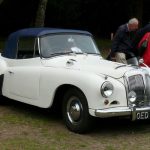There’s a typically British complexity to the rules around the registration numbers and letters placed on all cars in the United Kingdom. Because of those rules, certain number plates can be worth as much as the cars wearing them.
There are laws for the colour of the background (reflective, white on the front, yellow on the back, with no background pattern), the colour of the letters (one shade of black, although since 2021 they can be raised), and the other markings they contain (national flags and manufacturer are fine, anything else isn’t). Get it wrong, and you’ll face a £1000 fine, although those rules only apply to modern cars. If you have a classic, its number plate, also called a registration plate, can be completely different, depending on when the car was made: some painted on, some raised white plastic digits on a black background, some silver-on-black.

The most unusual characteristic of British number plates, though, is that they are individual entities in their own right, separate from the car they sit on. This means they can exist indefinitely and, as long as you’re not trying to pretend a car is newer than it is, be transferred to another car. Most importantly, if you pay £80 to the government’s Driver and Vehicle Licencing Agency (DVLA), you can hold the plate “on retention” on a paper document. That means the number plate can be traded separately from a vehicle. And wow, how some of these number plates are traded. For the most desirable ones, six-figure prices aren’t unheard of.

So, what makes a number plate valuable? To answer that requires a little history. First issued in 1903, the earliest British number plates were a combination of one- or two-letter codes followed by a number from 1 to 1000. The code depended on which local office issued the plate. Initially, it was a single letter: “A” was London, “O” for Birmingham, etc. Predictably, these combinations soon ran out and a second letter code was added. In 1932, it became three letters. “I”, “Q”, and “Z” were not used, in case they were confused with numbers, although Q later returned for a specific purpose I’ll get to in a bit.
By the 1950s, the codes were running out again, and so the numbers and letters were reversed, resulting in a “9999 AA” plate. In 1963, an age identifier “A” was added to the end, advancing through the alphabet every year starting in August. In 1983, this was moved to the front of the plate and the numbers placed in front of the letters. Therefore, you can tell that “ABC 1234 G” is a plate issued from August 1968 to July 1969 and “G123 ABC” was issued from August 1989 to July 1990. Finally, in 2001, the current style was started. It’s a two-letter local identifier, a two-number age-related tag, and then three random letters.
You see how complicated it is, which is why simple number plates gained cachet, desirability, and value. Today, the very earliest plates combining one or two letters with a single number are the most desirable, and people pay a huge amount for them. For example “25 O” was sold in 2014 for an astonishing £518,480. Naturally, the plate went straight onto a 250-powered Ferrari. But this wasn’t a one-off. “X1″, “G1”, “RR1”, and “F1” have all sold for more than £400,000.

Further down the pecking order, prefix and suffix number plates also change hands for hundreds (sometimes thousands) of pounds. Some are just bought to hide the real age of a vehicle, others for personal reasons: Tyson Fury, the heavyweight boxer born in 1988 and nicknamed the Gypsy King, has “88 GK” on one of his cars and “1 TLF” (his middle name is Luke) on another. Others look like full words: “COM 1C” is owned by a famous British comedian, and “MAG 1C” by, you guessed it, a magician. Some of these are a bit vague but still valuable: “WE57 HAM” sold to a West Ham football supporter for £57,000 and “EVR 70N” to an Everton supporter for a bargain £6400. Today, it’s a big business with the DVLA regularly auctioning unissued plates as well as big companies stocking and reselling them for a profit, although some considered inappropriate are never offered onto the market: In recent years, “BU18 SHT” was banned, as were any plates containing “ASS” or “SEX”.
So, in general, the earlier and shorter the plate, the more valuable. But there’s a flip side: Sell your plate, and it could affect the value of your car. Just as collectors in every part of the world love “matching numbers” when it comes to chassis and engines, British car buyers and collectors love an original number plate, issued with the car when it was new and adorning it ever since. Plus, if you do sell the valuable plate off your classic car, the DVLA will issue you with another appropriate number. Sometimes, if your car has been modified, this starts with the letter “Q” and that’s the kiss of death, an ever-visible mark that your car isn’t quite what it seems. Values follow suit.
Vanity, individuality, or just an easy way to remember your registration number, British number plates are a unique phenomenon.







WANTED : Licence plate 124 HRS please
I think the UK is the only country where the plate shows the year of registration. We must impress the neighbours!